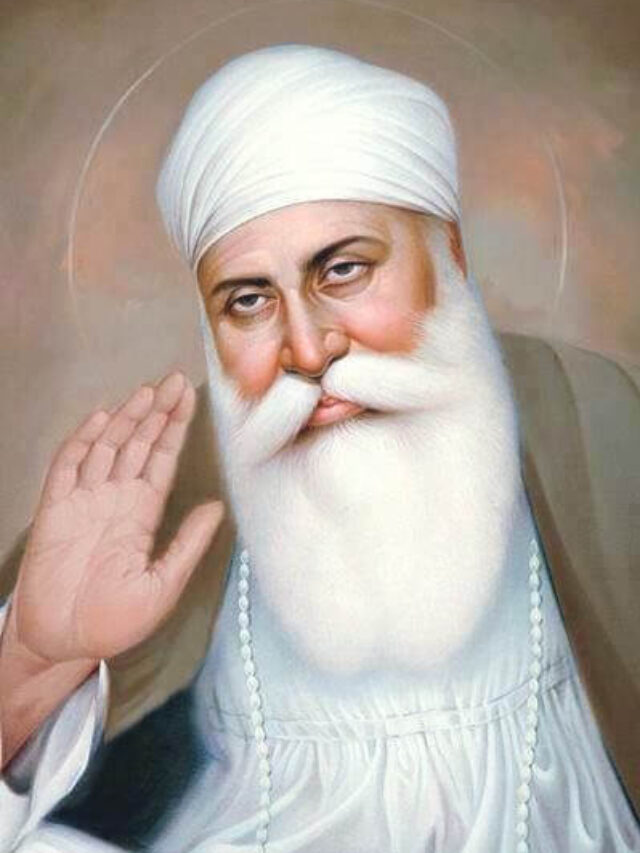
Table of Contents
Introduction / परिचय
The tenth and final human Sikh Guru, Guru Gobind Singh ji, made numerous contributions to Sikhism that will never be forgotten. This article will explore the life of Guru Gobind Singh, offering a thorough understanding of his legacy, from his birth and family history to the wars he led and the founding of the Khalsa.
दसवें और अंतिम मानव सिख गुरु, गुरु गोबिंद सिंह ने सिख धर्म में कई योगदान दिए जिन्हें कभी नहीं भुलाया जाएगा। यह लेख गुरु गोबिंद सिंह के जीवन का पता लगाएगा, उनके जन्म और पारिवारिक इतिहास से लेकर उनके द्वारा किए गए युद्धों और खालसा की स्थापना तक, उनकी विरासत की गहन समझ प्रदान करेगा।
Guru Gobind Singh Ji Jayanti 2024 / गुरु गोबिंद सिंह जयंती 2024
in 2024, commemorating Guru Gobind Singh’s birth anniversary. Discover the significance of this auspicious day, the customs observed, and the Guru-honoring events planned. Come celebrate Guru Gobind Singh Jayanti with the Sikh community on Wednesday, January 17, 2024.
2024 में, गुरु गोबिंद सिंह की जयंती मनाई जाएगी। इस शुभ दिन के महत्व, मनाए जाने वाले रीति-रिवाजों और नियोजित गुरु-सम्मान कार्यक्रमों के बारे में जानें। आइए बुधवार, 17 जनवरी 2024 को सिख समुदाय के साथ गुरु गोबिंद सिंह जयंती मनाएं।
Birth / जन्म
Born as Gobind Rai, Guru Gobind Singh Ji was the son of Guru Tegh Bahadur and Mata Gujri. He was born in Patna, Bihar, on December 22, 1666. His early upbringing was characterized by a fusion of martial and spiritual influences because he was a member of the Punjabi Khatri community’s Sodhi clan.
गोबिंद राय के रूप में जन्मे गुरु गोबिंद सिंह, गुरु तेग बहादुर और माता गुजरी के पुत्र थे। उनका जन्म 22 दिसंबर, 1666 को पटना, बिहार में हुआ था। उनकी प्रारंभिक परवरिश मार्शल और आध्यात्मिक प्रभावों के मिश्रण से हुई थी क्योंकि वह पंजाबी खत्री समुदाय के सोढ़ी कबीले के सदस्य थे।
Family and Early Life / परिवार और प्रारंभिक जीवन
The young Guru Gobind Singh Ji was raised in a spiritually enlightened environment where he was instilled with values that would shape his future as a warrior, philosopher, and leader.
युवा गुरु गोबिंद सिंह का पालन-पोषण आध्यात्मिक रूप से प्रबुद्ध वातावरण में हुआ था, जहाँ उन्हें ऐसे मूल्यों से भर दिया गया था जो एक योद्धा, दार्शनिक और नेता के रूप में उनके भविष्य को आकार देंगे।
Education and Spiritual Training / शिक्षा एवं आध्यात्मिक प्रशिक्षण
In addition to academics, Gobind Singh Ji received instruction in martial arts and spirituality. The Guru’s early life prepared him for his role as a warrior, poet, and philosopher. He learned Farsi and mastered the art of war.
शिक्षा के अलावा, गोबिंद सिंह ने मार्शल आर्ट और आध्यात्मिकता की शिक्षा भी प्राप्त की। गुरु के प्रारंभिक जीवन ने उन्हें एक योद्धा, कवि और दार्शनिक के रूप में उनकी भूमिका के लिए तैयार किया। उन्होंने फ़ारसी सीखी और युद्ध कला में महारत हासिल की।
Founding the Khalsa / खालसा की स्थापना
The Khalsa was founded in 1699, a revolutionary move in Sikhism spearheaded by Guru Gobind Singh Ji. This section examines the occasions that preceded this momentous occasion, such as the Panj Pyare and the baptism ritual that established the Khalsa community.
खालसा की स्थापना 1699 में हुई थी, जो गुरु गोबिंद सिंह के नेतृत्व में सिख धर्म में एक क्रांतिकारी कदम था। यह खंड उन अवसरों की जांच करता है जो इस महत्वपूर्ण अवसर से पहले हुए थे, जैसे कि पंज प्यारे और बपतिस्मा अनुष्ठान जिसने खालसा समुदाय की स्थापना की।
The Five K’s Tradition / पाँच K की परंपरा
The Five Ks, which were introduced by Gobind Singh Ji and are now recognized as the quintessential symbols of Khalsa identity, are uncut hair (Kesh), a wooden comb (Kangha), an iron or steel bracelet (Kara), a sword (Kirpan), and short breeches (Kacchera). The meaning of each K and the Khalsa warriors’ code of discipline are explained in this section.
पांच के, जो गोबिंद सिंह द्वारा पेश किए गए थे और अब खालसा पहचान के सर्वोत्कृष्ट प्रतीक के रूप में पहचाने जाते हैं, बिना कटे बाल (केश), एक लकड़ी की कंघी (कंघा), एक लोहे या स्टील का कंगन (कारा), एक तलवार (किरपान) हैं। , और छोटी जांघिया (कचेरा)। इस खंड में प्रत्येक K का अर्थ और खालसा योद्धाओं की अनुशासन संहिता बताई गई है।
Challenges and Wars / चुनौतियाँ और युद्ध
Guru Gobind Singh had to overcome many obstacles, both internal and external. This section illuminates the Guru’s tactics and leadership in the face of hardship, from fighting the Mughal Empire in 21 wars to institutionalizing the Khalsa.
गुरु गोबिंद सिंह को आंतरिक और बाहरी दोनों तरह की कई बाधाओं को पार करना पड़ा। यह खंड 21 युद्धों में मुगल साम्राज्य से लड़ने से लेकर खालसा को संस्थागत बनाने तक, कठिनाइयों का सामना करने में गुरु की रणनीति और नेतृत्व पर प्रकाश डालता है।
Battles / लड़ाई
The Guru led his army valiantly, taking an active part in battles. Examine the significant fights that Guru Gobind Singh Ji engaged in and the effects they had on Sikh history.
गुरु ने युद्धों में सक्रिय भाग लेते हुए बहादुरी से अपनी सेना का नेतृत्व किया। गुरु गोबिंद सिंह द्वारा लड़ी गई महत्वपूर्ण लड़ाइयों और सिख इतिहास पर उनके प्रभावों की जांच करें।
| Battle | Year | Opponents | Outcome | Significance |
|---|---|---|---|---|
| Battle of Anandpur (1682) | 1682 | Bhim Chand | – | Bhim Chand attacks Gobind Singh |
| Battle Of Anandpur (1685) | 1685 | Bhim Chand | – | Bhim Chand attacks Gobind Singh again |
| Battle of Bhangani (1688) | 1688 | Fateh Shah, Hayat Khan, Najabat Khan | – | Fateh Shah attacks Gobind Singh’s forces |
| Battle of Nadaun (1691) | 1691 | Mian Khan, Alif Khan | Victory for Gobind Singh | Defeat of Islamic armies |
| Battle of Anandpur (1695) | 1695 | Mughals | – | Mughals attack Gobind Singh at Anandpur |
| Battle of Guler (1696) | 1696 | Rustam Khan, Hussain Khan | Victory for Gobind Singh | Defeat of the Muslim army |
| Battle of Anandpur (1699) | 1699 | Two Rajas of the hills | – | Battle against Hill Rajas |
| Battle of Anandpur (1700) | 1700 | Aurangzeb’s Mughal army | Victory for Gobind Singh | Defeat of the Mughal army |
| First siege of Anandpur | 1701 | Hill Rajas, Gujar, other tribes | Gobind Singh’s victory | Brilliant defense by Ajit Singh |
| Battle of Taragarh | – | – | Defended during the Siege of Anandpur | Part of the Anandpur Siege |
| Battle of Nirmohgarh (1702) | 1702 | Aurangzeb’s forces, Wazir Khan | – | Continued for two days with heavy losses |
| Battle of Basoli (1702) | 1702 | Mughal army, Raja Dharampul, Raja Ajmer Chand | Tactical peace | Support from Basoli against Mughals |
| First Battle of Chamkaur (1702) | 1702 | Mughal Army | Mughal Army repulsed | Successful defense by Gobind Singh |
| Battle of Anandpur (1703) | 1703 | Sikhs vs Hill Rajas | Victory for Sikhs | Sikhs emerge victorious |
| First Battle of Anandpur (1704) | 1704 | Mughal army under Saiyad Khan, later Ramjan Khan | Mughals forced to withdraw | Death of Ramjan Khan |
| Second siege of Anandpur | 1704 | Mughal army under Wazir Khan and Zaberdast Khan | Siege and battles | Prolonged siege leading to evacuation |
| Battle of Sarsa (1704) | 1704 | Mughal army under Wazir Khan | Sikhs faced heavy casualties | Retreating Sikhs attacked |
| Battle of Chamkaur (1704) | 1704 | Mughal army under Nahar Khan | Significant losses on both sides | Death of Guru’s sons |
| Battle of Muktsar (1705) | 1705 | Mughal army under Wazir Khan | Sikh losses, end of Guru’s battles | Last battle led by Guru Gobind Singh |
| Battle of Baghaur (1707) | 1707 | Raja of Bhghaur | – | Dispute over camels led to the battle |
| Battle of Jajau (1707) | 1707 | Azam Shah, Bhadur Shah | Guru Gobind Singh assisted Bahadur Shah | Guru provided assistance in the Mughal throne dispute |
Sikh Scriptures
This article examines the influence of Guru Gobind Singh Ji on Sikh scriptures, specifically the Dasam Granth and the Guru Granth Sahib. There is a thorough discussion of the disputes surrounding the Dasam Granth and how they affect Sikh rituals.
यह लेख सिख धर्मग्रंथों, विशेष रूप से दशम ग्रंथ और गुरु ग्रंथ साहिब पर गुरु गोबिंद सिंह के प्रभाव की जांच करता है। दशम ग्रंथ से जुड़े विवादों और वे सिख रीति-रिवाजों को कैसे प्रभावित करते हैं, इस पर गहन चर्चा की गई है।
Relationship with Other Religious Groups / अन्य धार्मिक समूहों के साथ संबंध
Guru Gobind Singh Ji imposed social segregation between the Khalsa and Muslims in reaction to the hostile atmosphere. This section explores the historical background as well as the Sikh tradition’s position on relations with other religions.
शत्रुतापूर्ण माहौल की प्रतिक्रिया में गुरु गोबिंद सिंह ने खालसा और मुसलमानों के बीच सामाजिक अलगाव लागू कर दिया। यह खंड ऐतिहासिक पृष्ठभूमि के साथ-साथ अन्य धर्मों के साथ संबंधों पर सिख परंपरा की स्थिति की पड़ताल करता है।
Post-War Years / युद्धोत्तर वर्ष
The Guru’s life took many different turns following the conflicts and battles. This section offers an insight into Guru Gobind Singh’s Ji post-war years, including his interactions with reliable Sikhs and his time spent living in hiding in various parts of India.
संघर्षों और लड़ाइयों के बाद गुरु के जीवन में कई अलग-अलग मोड़ आए। यह खंड गुरु गोबिंद सिंह के युद्ध के बाद के वर्षों की जानकारी प्रदान करता है, जिसमें विश्वसनीय सिखों के साथ उनकी बातचीत और भारत के विभिन्न हिस्सों में छुपकर बिताया गया समय शामिल है।
| Year | Events and Developments |
|---|---|
| 1705 | Post Battle of Muktsar: Guru Gobind Singh Ji continued to lead the Sikh community after the Battle of Muktsar, marking the end of active military engagements. |
| 1708 | Passing of Guru Gobind Singh Ji: Guru Gobind Singh Ji left this world on October 7, 1708. The Guru Granth Sahib, the holy scripture, became the eternal Guru. |
| 1708 | Guru Granth Sahib as Guru: Guru Gobind Singh Ji declared Guru Granth Sahib as the eternal Guru, ensuring spiritual guidance for the Sikhs. |
| 1708 | Khalsa Brotherhood: The Khalsa, established earlier, continued to evolve as a community of initiated Sikhs committed to principles of righteousness. |
| 1708 | Legacy of Guru Gobind Singh Ji: Guru Gobind Singh’s teachings and principles laid the foundation for Sikhism and continue to inspire followers globally. |
Zafarnama – Epistle of Victory / ज़फ़रनामा – विजय का संदेश
In his letter to Aurangzeb, known as the Zafarnama, Guru Gobind Singh expresses his feelings regarding the injustice and betrayal he endured. This section explores the historical significance and content of the Zafarnama.
औरंगज़ेब को लिखे अपने पत्र में, जिसे ज़फ़रनामा के नाम से जाना जाता है, गुरु गोबिंद सिंह ने अपने साथ हुए अन्याय और विश्वासघात के बारे में अपनी भावनाएँ व्यक्त की हैं। यह खंड ज़फरनामा के ऐतिहासिक महत्व और सामग्री की पड़ताल करता है।
| Title: | Zafarnama (The Epistle of Victory) |
|---|---|
| Language: | Persian |
| Recipient: | Aurangzeb, the Mughal Emperor |
| Date: | Completed on 29th March 1705, written during the siege of Anandpur but delivered later in 1707 |
| Context: | Guru Gobind Singh Ji wrote the letter to Aurangzeb after the Battle of Chamkaur |
| Purpose: | Condemnation of Aurangzeb’s betrayal and tyranny, expressing hope for justice and righteousness |
| Contents: | – Exposition of the moral and spiritual principles upheld by the Sikhs |
| – Urges Aurangzeb to reflect on his actions and seek redemption | |
| – Affirms the resilience and unyielding spirit of the Sikh community | |
| Style: | Eloquent and bold, characterized by poetic expressions and fervent language |
| Themes: | – Justice, righteousness, and the struggle against tyranny |
| – Resilience, courage, and commitment to Sikh values | |
| Impact: | The Zafarnama is considered a masterpiece of Persian literature and a testament to Sikh valor |
Guru Gobind Singh ji Death of Family Members / परिवार के सदस्यों की मृत्यु
Guru Gobind Singh’s Ji family suffered a tragedy when his four sons passed away too soon. The horrific events, which include the execution of the younger sons, Fateh Singh and Zorawar Singh, are described in this section.
गुरु गोबिंद सिंह के परिवार को उस समय त्रासदी का सामना करना पड़ा जब उनके चार पुत्रों का बहुत जल्द निधन हो गया। इस खंड में भयानक घटनाओं का वर्णन किया गया है, जिसमें छोटे बेटों, फ़तेह सिंह और ज़ोरावर सिंह की फाँसी शामिल है।
| Family Member | Date of Death | Circumstances |
|---|---|---|
| Mata Jito (Wife) | December 1700 | Passed away during the difficult times of the siege of Anandpur. |
| Sahibzada Ajit Singh (Son) | December 7, 1705 | Martyred in the Battle of Chamkaur, defending against the Mughal army. |
| Sahibzada Jujhar Singh (Son) | December 7, 1705 | Also martyred in the Battle of Chamkaur alongside his elder brother, Ajit Singh. |
| Sahibzada Zorawar Singh (Son) | December 26, 1705 | Captured during the evacuation from Anandpur and executed by the Mughals at a young age. |
| Mata Gujari (Mother) | December 1705 | Passed away in the custody of the Mughals after the evacuation from Anandpur, grieving the loss of her grandsons. |
Final Days and Legacy / अंतिम दिन और विरासत
The last days of Guru Gobind Singh Ji and his lasting influence are discussed in the article’s conclusion. This section highlights the founding of Sikh principles, the Khalsa tradition, and the lasting influence on Sikhism.
लेख के निष्कर्ष में गुरु गोबिंद सिंह के अंतिम दिनों और उनके स्थायी प्रभाव की चर्चा की गई है। यह खंड सिख सिद्धांतों की स्थापना, खालसा परंपरा और सिख धर्म पर स्थायी प्रभाव पर प्रकाश डालता है।
| Event | Date | Details |
|---|---|---|
| Leaving Anandpur | December 1704 | Because of the protracted siege, Aurangzeb offered safe passage for Guru Gobind Singh Ji, his family, and a few Sikhs to leave Anandpur. लंबी घेराबंदी के कारण, औरंगजेब ने गुरु गोबिंद सिंह, उनके परिवार और कुछ सिखों को आनंदपुर छोड़ने के लिए सुरक्षित मार्ग की पेशकश की। |
| Attack During Departure | December 1704 | The Guru’s group came under attack as they were departing Anandpur in two batches. Guru’s mother Mata Gujari, along with his two sons, Zorawar Singh and Fateh Singh, were apprehended. Later, the young sons were put to death. गुरु के समूह पर उस समय हमला हुआ जब वे दो जत्थों में आनंदपुर से प्रस्थान कर रहे थे। गुरु की माँ माता गुजरी, उनके दो पुत्रों, जोरावर सिंह और फतेह सिंह, को पकड़ लिया गया। बाद में जवान बेटों को मौत के घाट उतार दिया गया. |
| Execution of Sons and Death of Mata Gujari | December 1704 | The two younger sons of Guru Gobind Singh, Zorawar Singh (eight years old) and Fateh Singh (five years old), were buried alive in a wall as a means of execution. The grandmother, Mata Gujari, also passed away in this terrible event. गुरु गोबिंद सिंह के दो छोटे पुत्रों, जोरावर सिंह (आठ वर्ष) और फतेह सिंह (पांच वर्ष) को फाँसी के तौर पर एक दीवार में जिंदा दफना दिया गया था। इस भयानक घटना में दादी माता गुजरी का भी निधन हो गया। |
| Retreat to Chamkaur Sahib | December 1704 | Following the tragic events at Anandpur, Guru Gobind Singh Ji withdrew to Chamkaur Sahib with a small group of Sikhs. आनंदपुर की दुखद घटनाओं के बाद, गुरु गोबिंद सिंह सिखों के एक छोटे समूह के साथ चमकौर साहिब चले गए। |
| Battle of Chamkaur Sahib | December 1704 | One of the biggest fights in Sikh history, according to many. Against a sizable Mughal force, Guru Gobind Singh Ji and a small group of Sikhs protected Chamkaur Sahib. In this battle, Ajit Singh and Jujhar Singh, the elder sons of the Guru, were martyred. कई लोगों के अनुसार, यह सिख इतिहास की सबसे बड़ी लड़ाइयों में से एक है। एक बड़ी मुगल सेना के खिलाफ, गुरु गोबिंद सिंह और सिखों के एक छोटे समूह ने चमकौर साहिब की रक्षा की। इस युद्ध में गुरु के बड़े पुत्र अजीत सिंह और जुझार सिंह शहीद हो गये। |
| Retreat to Muktsar | December 1704 – January 1705 | Guru Gobind Singh Ji and the few Sikh survivors after the Battle of Chamkaur Sahib withdrew to Muktsar. चमकौर साहिब की लड़ाई के बाद गुरु गोबिंद सिंह और बचे हुए कुछ सिख मुक्तसर चले गए। |
| Battle of Muktsar | January 1705 | The Wazir Khan-led Mughal army attacked the army of Guru Gobind Singh Ji. The fight happened in the dry region of Khidrana-ki-Dhab. It was the final battle that Guru Gobind Singh led, and many Sikh lives were lost. वजीर खान के नेतृत्व वाली मुगल सेना ने गुरु गोबिंद सिंह की सेना पर हमला कर दिया। यह लड़ाई खिदराना-की-ढाब के शुष्क क्षेत्र में हुई। यह अंतिम लड़ाई थी जिसका नेतृत्व गुरु गोबिंद सिंह ने किया और इसमें कई सिखों की जान चली गई। |
| Passing of Guru Gobind Singh | October 7, 1708 (Nanakshahi calendar date) | The death of Guru Gobind Singh occurred in Nanded, Maharashtra. He proclaimed the holy text, the Guru Granth Sahib, to be the eternal guide of the Sikhs just before he passed away. गुरु गोबिंद सिंह की मृत्यु महाराष्ट्र के नांदेड़ में हुई थी। अपने निधन से ठीक पहले उन्होंने पवित्र ग्रंथ, गुरु ग्रंथ साहिब को सिखों का शाश्वत मार्गदर्शक घोषित किया। |
Conclusion / निष्कर्ष
The life of Guru Gobind Singh Ji was a tapestry with literary, spiritual, and combative elements. He is a respected figure in Sikh history because of his teachings and selflessness, which have inspired millions of people. Thinking back on his life serves as a reminder of the enormous influence one person can have on the path of history.
गुरु गोबिंद सिंह का जीवन साहित्यिक, आध्यात्मिक और जुझारू तत्वों से भरपूर था। वह अपनी शिक्षाओं और निस्वार्थता के कारण सिख इतिहास में एक सम्मानित व्यक्ति हैं, जिसने लाखों लोगों को प्रेरित किया है। उनके जीवन के बारे में सोचने से यह याद आता है कि इतिहास के पथ पर एक व्यक्ति का कितना बड़ा प्रभाव हो सकता है।
Shaheedi Diwas of Sahibzade 2023
FAQs
When was Guru Gobind Singh Ji born?
Guru Gobind Singh Ji was born on 22nd December 1666 in Patna, Bihar.
गुरु गोबिंद सिंह का जन्म 22 दिसंबर 1666 को पटना, बिहार में हुआ था।
What are the Five Ks of Sikhism?
The uncut hair (Kesh), the wooden comb (Kangha), the sword (Kirpan), the iron or steel bracelet (Kara), and the short breeches (Kacchera) are known as the Five Ks.
बिना कटे बाल (केश), लकड़ी की कंघी (कंघा), तलवार (किरपान), लोहे या स्टील का कंगन (कारा), और छोटी जांघिया (कचेरा) को पांच के के रूप में जाना जाता है।
How many wars did Guru Gobind Singh Ji fight?
In twenty-one battles, Guru Gobind Singh fought the Mughal Empire.
इक्कीस लड़ाइयों में, गुरु गोबिंद सिंह ने मुगल साम्राज्य से लड़ाई लड़ी।
What is the Zafarnama?
Guru Gobind Singh wrote an epistle to Aurangzeb called the Zafarnama in which he discussed his beliefs regarding injustice and betrayal.
गुरु गोबिंद सिंह ने औरंगज़ेब को ज़फ़रनामा नामक एक पत्र लिखा जिसमें उन्होंने अन्याय और विश्वासघात के बारे में अपनी मान्यताओं पर चर्चा की।
How did Guru Gobind Singh’s sons die?
Fateh Singh and Zorawar Singh, the two younger sons of Guru Gobind Singh, were put to death.
गुरु गोबिंद सिंह के दो छोटे पुत्रों फतेह सिंह और जोरावर सिंह को मौत की सजा दी गई।
What is Guru Gobind Singh Indraprastha University?
Delhi, India is home to the public state university known as Guru Gobind Singh Indraprastha University (GGSIPU). It was founded by the Government of the National Capital Territory of Delhi and provides a range of undergraduate, graduate, and doctorate programs in various fields.
दिल्ली, भारत सार्वजनिक राज्य विश्वविद्यालय का घर है जिसे गुरु गोबिंद सिंह इंद्रप्रस्थ विश्वविद्यालय (जीजीएसआईपीयू) के नाम से जाना जाता है। इसकी स्थापना राष्ट्रीय राजधानी क्षेत्र दिल्ली सरकार द्वारा की गई थी और यह विभिन्न क्षेत्रों में स्नातक, स्नातकोत्तर और डॉक्टरेट कार्यक्रमों की एक श्रृंखला प्रदान करता है।
How many wars did Guru Gobind Singh fight?
Guru Gobind Singh fought in 21(twenty-one battles) wars against the Mughal Empire.
गुरु गोबिंद सिंह ने मुगल साम्राज्य के खिलाफ 21 (इक्कीस लड़ाइयाँ) लड़ीं।
How did Guru Gobind Singh die?
An assassin’s gunshot wounds claimed Guru Gobind Singh’s life. On October 7, 1708, in Nanded, Maharashtra, he was assassinated.
एक हत्यारे की गोली के घाव ने गुरु गोबिंद सिंह की जान ले ली। 7 अक्टूबर, 1708 को महाराष्ट्र के नांदेड़ में उनकी हत्या कर दी गई।
Who was Guru Gobind Singh?
The tenth Sikh Guru, Guru Gobind Singh, was a poet, philosopher, and military and spiritual leader who had a significant influence on the development of Sikhism.
दसवें सिख गुरु, गुरु गोबिंद सिंह, एक कवि, दार्शनिक और सैन्य और आध्यात्मिक नेता थे जिनका सिख धर्म के विकास पर महत्वपूर्ण प्रभाव था।
When is Guru Gobind Singh Jayanti in 2022?
The fifth of January 2022 was designated as Guru Gobind Singh Jayanti. 5jan2022
पांच जनवरी 2022 को गुरु गोबिंद सिंह जयंती के रूप में नामित किया गया था।
Who was the eldest son of Guru Gobind Singh Ji?
Ajit Singh was the eldest son of Guru Gobind Singh Ji.
अजीत सिंह गुरु गोबिंद सिंह जी के सबसे बड़े पुत्र थे।
When is Guru Gobind Singh Jayanti in 2023?
The date of Guru Gobind Singh Jayanti in 2023 is set for December 29.
2023 में गुरु गोबिंद सिंह जयंती की तारीख 29 दिसंबर तय की गई है.
When is Guru Gobind Singh Jayanti in 2024?
The date of Guru Gobind Singh Jayanti in 2024 is set for January 17.
Who was the mother of Guru Gobind Singh Ji?
Mata Gujri was the mother of Guru Gobind Singh Ji.
माता गुजरी गुरु गोबिंद सिंह जी की माता थीं।
How did Guru Gobind Singh die in Hindi?
गुरु गोबिंद सिंह की मौत गोलियों से हुई थी जिन्होंने एक जानलेवा हमला किया था। उनकी हत्या 1708 में, महाराष्ट्र के नांदेड़ में की गई थी।
Name the sons of Guru Gobind Singh Ji who were bricked alive.
Fateh Singh and Zorawar Singh, the younger sons of Guru Gobind Singh Ji, were bricked alive.
गुरु गोबिंद सिंह जी के छोटे पुत्रों फतेह सिंह और जोरावर सिंह को जिंदा ईंटों से मार दिया गया।
Who was the youngest son of Guru Gobind Singh Ji?
Fateh Singh and Zorawar Singh were Guru Gobind Singh Ji’s youngest sons.
फ़तेह सिंह और ज़ोरावर सिंह गुरु गोबिंद सिंह जी के सबसे छोटे पुत्र थे।
Who was the eldest son of Guru Gobind Singh Ji?
Ajit Singh was the eldest son of Guru Gobind Singh Ji.
अजीत सिंह गुरु गोबिंद सिंह जी के सबसे बड़े पुत्र थे।









